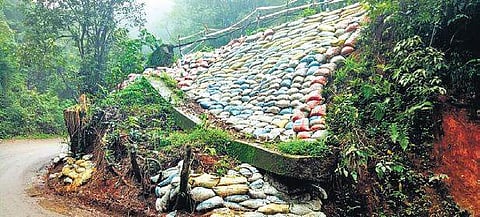

BENGALURU: Walls do not help in controlling soil erosion along the coasts, infact they make matters worse, noted experts and forest department officials. Hence, action will be taken to increase the natural green barriers by planting trees, creating mangroves and strengthening estuaries, in order to control sea sand erosion and improve Karnataka’s coastline.
Under Karnataka-Shore (K-Shore), the forest department is working on planting ten rows of trees. If all goes as per plan, then Karnataka can be the first state to implement the green barriers in the coastal areas. However, Tamil Nadu has already been working on the same project and they are better placed when compared to Karnataka in their work. Karnataka is behind schedule in its planning because of the assembly and parliament elections.
“Creating concrete walls is not the solution for controlling soil erosion, more natural solutions are needed to tackle the issue. We presented this plan to the NITI Ayog in 2023, and they agreed to support the five-year-long project. Even the World Bank has agreed to fund 70 per cent of the project cost which is Rs 840 crore. The final project report detailing the work for the next five years will also be submitted to World Bank before starting the work on ground,” said a senior forest official working on the project.
Of the 320 kms coastline of Karnataka, the state forest department along with ministry of environment, forests and climate change (MoEFCC) and Port Authority of India (PAI) have identified 240 kms stretch, where the plantation project can take place. Fishermen and village panchayats are also keen about the project, as it will help them revive the native fish population.
“It is important to stabilise soil erosion during high tide and low tide. Earlier, area specific plantation was present in patches across the coast line. But they were destroyed over the years. Places where mangroves previously existed, are being surveyed. Saplings will be raised in nurseries during the monsoon season, and from October they will be planted into the land,” the official said.
As per reports, from 2011 to 2022 the PAI had spent Rs 271.78 crore on constructing walls. When the state took up wall building works in Karwar, Udupi, Mangaluru and other surrounding areas, in 2022 and 2023, the neighbouring states had complained that this was leading to heavy sea erosion and high tide in the beaches and effecting the fishermen.
The MoEFCC officials said due to construction of walls, the hydro-static pressure of the waves shifted aggressively to other areas. The salinity and heat on the sea shore changed, and affected the aqua life. Besides, the walls collapsed during high tide, and large chunks of land was flowing into the sea. With the green cover, these situations can be avoided, explained the official.